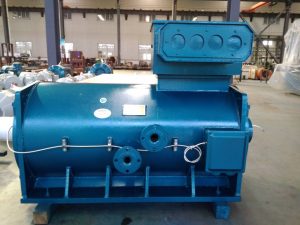PREVIEW
What is Permanent Magnet Synchronous Motor
Today, AC induction motors continue to be widely used in various products. However, there is a growing trend among engineers and equipment owners to adopt permanent magnet motor solutions for many applications. This shift is primarily driven by the smaller size and higher efficiency offered by permanent magnet motors. They have proven to be particularly suitable for applications such as fans, blowers, and pumps.

One type of permanent magnet motor is the permanent magnet synchronous motor (PMSM), which can be likened to a brushless direct current (BLDC) motor. PMSMs, like BLDC motors, are electric motors that rotate. They possess permanent magnet rotors and wound stators. With their three-phase stator layout, they are designed to create a sinusoidal flux distribution in the air gap, resulting in a sinusoidal back electromotive force (BEMF). This characteristic is advantageous for achieving efficient motor operation.
The Key Features of Permanent Magnet Synchronous Motor
Construction: PMSMs have a relatively simple mechanical design that makes them easy to maintain and repair. Their construction typically involves a fixed stator made of ferromagnetic material, permanent magnets attached to the rotor, and a set of copper windings.
Rugged Composition: PMSMs are designed to withstand a range of environmental conditions, including temperature extremes, moisture, and vibration. This ruggedness makes them suitable for use in diverse applications, including automotive and industrial systems.
High Reliability: A major advantage of PMSMs is their reliability, especially at high operating speeds. They have no brushes or commutators to wear out, and therefore, there is no loss of speed control due to mechanical wear.
Variable Speed Drive: PMSMs can be driven by variable speed drives (VSDs), allowing for precise control of the motor speed. This capability makes them suitable for applications where speed needs to be continuously adjusted based on changing conditions.

Sensorless Operation: PMSMs can operate without position or speed sensors, known as sensorless control. This removes the need for additional sensors, simplifying the system design and reducing costs.
Precise Torque and Speed Control: PMSMs allow for precise control of torque and speed through advanced control algorithms and feedback loops. This enables precise positioning, motion control, and accurate speed regulation.
Fast Dynamic Response: PMSMs have a fast dynamic response due to their high torque-to-inertia ratio and low moment of inertia. This makes them suitable for applications that require rapid acceleration or precise speed control.
Smooth Torque Production: PMSMs produce a smooth and continuous torque, ensuring smooth motion and minimal vibrations in the system. This makes them suitable for precision motion control applications such as robotics or precision machining.
Quiet Operation: PMSMs operate quietly due to their smooth torque production and lack of brushes or commutators. This makes them suitable for use in applications where noise reduction is important, such as in indoor environments or where people are present.